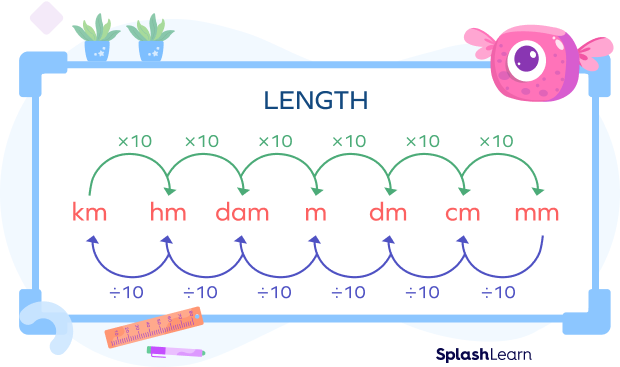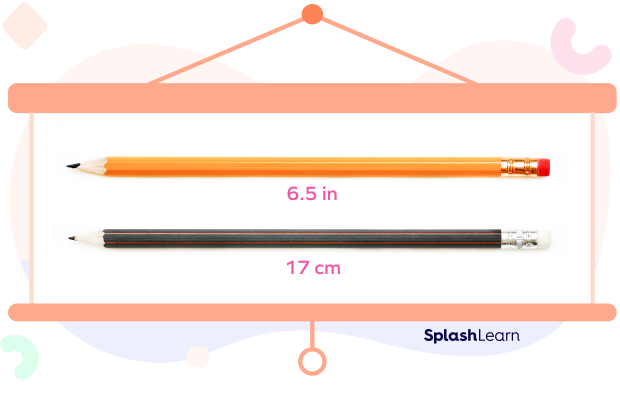What Is Length Conversion?
Length conversion refers to converting measurements of length or distance from one unit to another. This is typically done to express measurements in a more convenient or appropriate unit for a particular purpose or to compare lengths expressed with 2 different units.
Example: Suppose you have two ropes, one 15 inches long and the other 2 feet long. Which rope is longer? Can you compare 15 inches with 2 feet? No!
To compare the lengths, the two measurements must be in the same units. You must convert inches into feet or feet to inches and then compare. This is what we call a length conversion.
1 foot = 12 inches
2 feet = 24 inches > 15 inches
Thus, 2 feet > 15 inches
Length is a fundamental physical quantity, measured in units like meters, centimeters, inches, or feet, used to describe the size of an object from one end to another.
Recommended Games
Length Conversion: Definition
Length conversion is the process of converting the length measurements from one unit to another using the correct conversion factor, simplifying the comparison lengths expressed in different units.
Recommended Worksheets
Length Conversion in the Metric System
Converting lengths within the metric system is straightforward as it is based on the decimal system and only involves moving a decimal point. In this system, the unit “meter” acts as the base unit of length, and we can obtain smaller or larger units by attaching various prefixes such as kilo, hecto, deka, deci, centi, and milli to it.
Let’s quickly revise these units, their abbreviations, prefixes, and corresponding powers of 10.
| Kilometer | Hectometer | Decameter | Meter | Decimeter | Centimeter | Millimeter |
|---|---|---|---|---|---|---|
| km | hm | dam | m | dm | cm | mm |
| 103 | 102 | 101 | 100 = 1 | 10-1 | 10-2 | 10-3 |
How to Convert Lengths in the Metric System
Length measurement conversion in the metric system can be simplified using the following tricks:

- If you move n positions to the right from any place, you move n decimal places to the right. So multiply by 10n.
Examples:
- To convert meters (m) into decimeters (dm), multiply by 10. (1 m = 10 dm)
- To convert kilometers (km) into meters (m), multiply by 1000. (5 km = 5000 m)
- If you move n positions to the left from any place, you move n decimal places to the left. So divide by 10n (or multiply by 10-n).
Examples:
- To convert meters (m) into kilometers (km), divide by 1000. (6 m = 0.006 km)
- To convert millimeters (mm) into centimeters (cm), divide by 10. (7 mm = 0.7 cm)
Length Conversion in the Customary System
The customary system, primarily used in the United States, employs inches, yards, miles, and feet to measure lengths or distances. This system is based on the English system of measurement (the same system from which the Imperial system is also derived.)
While the metric system has largely replaced the Imperial system in many countries, the customary system remains prevalent in the United States.
Length conversions in the customary system:
- 1 foot = 12 inches
- 1 yard = 3 feet = 36 inches
- 1 mile = 5,280 feet
- 1 mile = 1,760 yards
Length Conversion Chart for the Customary System and Metric System
Here’s a length or distance conversion table for different units of length in the metric system and the customary system.
| 1 centimeter = 10 millimeters | 1 cm = 10 mm |
| 1 decimeter = 10 centimeters | 1 dm = 10 cm |
| 1 meter = 100 centimeters | 1 m = 100 cm |
| 1 kilometer = 1000 meters | 1 km = 1000 m |
| 1 inch = 2.54 centimeters | 1 in = 2.54 cm |
| 1 foot = 12 inches | 1 ft = 12 in |
| 1 yard = 3 feet = 36 inches | 1 yd = 3 ft = 36 in |
| 1 mile = 1,760 yards = 5,280 feet | 1 mi = 1,760 yd = 5,280 ft |
| 1 mile ≈ 1.61 kilometers | 1 mi ≈ 1.61 km |
Length Conversion in the Imperial System
The Imperial system is based on the English units. It’s closely related to the customary system, but the two systems have many differences.
- Familiar units include the inch, foot, yard, and mile.
- Units for land measurement consist of the furlong, chain, link, rod, pole, perch, and Ramsden’s chain.
- Nautical units include the fathom, shackle, cable, and nautical mile.
- Body measurements encompass the foot, hand, palm, nail, and finger.
Here are different Imperial units for length and their relationships:
| 1 nail | = $2\frac{1}{4}$inches |
| 4 inches | = 1 hand |
| 12 inches | = 1 foot |
| 3 foot | = 1 yard |
| 5.5 yards | = 1 rod |
| 6 foot | = 1 fathom |
| 22 yards | = 1 chain |
| 100 links | = 1 chain |
| 10 chains | = 1 furlong |
| 8 furlongs | = 1 statute mile |
| 6080 foot | = 1 nautical mile |
Length Conversion Table for the Imperial System and Metric System
| Imperial Units | Metric Units | |
|---|---|---|
| 1 nautical mile | 1.151 miles | 1852 meters |
| 1 mile | 1760 yards | 1609 meters |
| 1 furlong | 220 yards | 201 meters |
| 1 rod | 5.50 yards | 5.029 meters |
| 1 fathom | 6 feet | 1.829 meters |
| 1 yard | 3 feet | 0.9144 meters |
| 1 foot | 12 inches | 0.3048 meters |
| 1 Inch | 0.083 foot | 0.0254 meters |
Facts about Length Conversion
- The width of a human hair is typically measured in micrometers, which are one-millionth of a meter! That’s super tiny!
- Mount Everest, the tallest mountain on Earth, is approximately 8,848 meters or 29,029 feet. That’s nearly 5.5 miles high!
Conclusion
In this article, we learned about the fundamentals of length conversion in the metric, imperial, and customary systems. Let’s solidify our understanding by solving examples and practicing MCQs for better comprehension.
Solved Examples on Length Conversion
1. Convert 200 m to km.
Solution:
By the length conversion formula for meters to kilometers, we have
1 km = 1000 m
1 m = $\frac{1}{1000}$ km
200 m = $\frac{200}{1000}$ = 0.2 km
2. Which is longer? 48 inches or 4 feet?
Solution:
To compare lengths, bring both measurements in the same unit.
1 feet = 12 inches
4 feet = $12 \times 4$ inches = 48 inches
Thus, 48 inches = 4 feet
3. How many inches are there in 6 feet?
Solution:
1 feet = 12 inches
6 feet = $6 \times 12$ = 72 inches
4. How many millimeters are there in 4 hectometers?
Solution:
1 hectometer = 100 meter
1 meter = 1000 millimeters
To convert 1 hectometer into millimeters, you move 5 positions to the right.
So multiply by 105 = 1,00,000.
1 hectometer = 1,00,000 millimeters
4 hectometers = 4 × 1,00,000 = 4,00,000 millimeters
5. Which pencil is longer?

Solution:
Length of the yellow pencil = 6.5 in
Length of the black pencil = 17 cm
To compare lengths, they must be in the same units.
Let’s convert 6.5 inches into centimeters.
1 inch = 2.54 cm
Length of the yellow pencil = 6.5 inches = 6.5 × 2.54 cm = 16.51 cm
Here, 16.51 cm < 17 cm
Thus, the black pencil is longer.
Practice Problems on Length Conversion
Length Conversion - Metric and Customary System, Examples
On converting 10 yards into feet, we get
1 yard = 3 feet
10 yards = 10 ✕ 3 feet = 30 feet
How many meters are there in 900 millimeters?
1 meter = 1000 millimeters
1 millimeter = $\frac{1}{1000}$ millimeter
900 millimeters = $\frac{900}{1000}$ millimeter = 0.9 millimeter
Compare: 1 mile _____ 1 km
1 mile ≈ 1.61 km
Thus, 1 mile > 1 km
Frequently Asked Questions about Length Conversion
What is a micrometer?
A micrometer, also known as a micron, is a unit of length equal to one millionth of a meter (1 × 10-6 meters). It is commonly used to measure very small distances, such as the width of a human hair or the size of microorganisms.
What is a nanometer?
A nanometer is an even smaller unit of length, equal to one billionth of a meter (1 × 10-9 meters). It is used to measure atomic and molecular scales and the dimensions of nanoscale structures in fields like nanotechnology.
What’s a megameter and a gigameter?
1 megameter = 1,000 kilometers
1 gigameter = 1,000,000 kilometers
How do you convert miles into kilometers?
To convert miles into kilometers, you can use the conversion factor that 1 mile is approximately equal to 1.60934 kilometers. So, to convert miles into kilometers, you multiply the number of miles by 1.60934. Conversely, you divide the kilometers by 1.60934 to convert kilometers into miles.



































